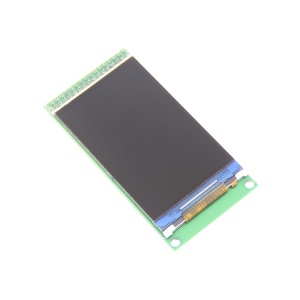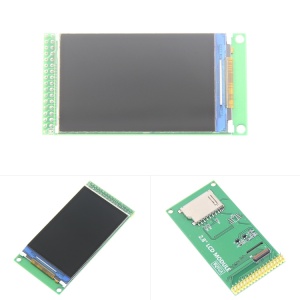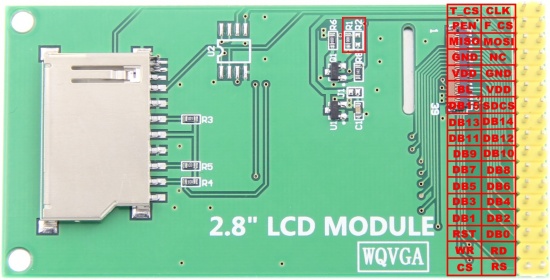| Line 80: | Line 80: | ||
The red box in the above figure is the 8-bit/16-bit data bus mode switch, which is described as follows: | The red box in the above figure is the 8-bit/16-bit data bus mode switch, which is described as follows: | ||
: | :Solder '''R1''' with 0Ω resistor or short circuit directly, and disconnect '''R2''': select '''16'''-bit data bus mode (default), use '''DB0~DB15''' data pin | ||
: | :Solder '''R2''' with 0Ω resistor or short circuit directly, and disconnect '''R1''': select '''8'''-bit data bus mode, use '''DB8~DB15''' data pin | ||
{| class="wikitable" border="1" style="width: 550px; background-color: white;" | {| class="wikitable" border="1" style="width: 550px; background-color: white;" | ||
Latest revision as of 09:42, 15 September 2019
Product Picture
Product Description
- 2.8-inch color screen, support 16BIT RGB 65K color display, display rich colors
- 240x400 resolution for clear display
- Support 8-bit/16-bit parallel bus switching (the default is 16-bit), fast transfer speed
- Supports ALIENTEK STM32 Mini, Elite, WarShip, Explorer, and Apollo development boards for direct plug-in use
- Support SD card function expansion
- Provides a rich sample program for STM32 and C51 platforms
- Military-grade process standards, long-term stable work
- Provide underlying driver technical support
Product Parameters
| Name | Parameter |
| Display Color | 16BIT RGB 65K color |
| SKU | MRB2802 |
| Screen Size | 2.8(inch) |
| Screen Type | TFT |
| Driver IC | R61509V |
| Resolution | 240*400 (Pixel) |
| Module Interface | 8Bit or 16Bit parallel interface |
| Active Area | 36.72x61.20 (mm) |
| Touch Screen Type | no touch screen |
| Touch IC | no touch IC |
| Module PCB Size | 43.64x85.74 (mm) |
| Operating Temperature | -20℃~60℃ |
| Storage Temperature | -30℃~70℃ |
| Operating Voltage | 3.3V/5V |
| Power Consumption | TBD |
| Rough Weight(Package containing) | TBD |
Interface Definition
The red box in the above figure is the 8-bit/16-bit data bus mode switch, which is described as follows:
- Solder R1 with 0Ω resistor or short circuit directly, and disconnect R2: select 16-bit data bus mode (default), use DB0~DB15 data pin
- Solder R2 with 0Ω resistor or short circuit directly, and disconnect R1: select 8-bit data bus mode, use DB8~DB15 data pin
| Number | Pin Label | Description |
| 1 | CS | LCD reset control pin( low level enable) |
| 2 | RS | LCD register / data selection control pin(high level: register, low level: data) |
| 3 | WR | LCD write control pin |
| 4 | RD | LCD read control pin |
| 5 | RST | LCD reset control pin( low level reset) |
| 6 | DB0 | LCD data bus low 8-bit pin(When 8-bit parallel data bus mode is selected, the lower 8-bit data pins are not used) |
| 7 | DB1 | |
| 8 | DB2 | |
| 9 | DB3 | |
| 10 | DB4 | |
| 11 | DB5 | |
| 12 | DB6 | |
| 13 | DB7 | |
| 14 | DB8 | LCD data bus high 8-bit pin |
| 15 | DB9 | |
| 16 | DB10 | |
| 17 | DB11 | |
| 18 | DB12 | |
| 19 | DB13 | |
| 20 | DB14 | |
| 21 | DB15 | |
| 22 | SDCS | SD card selection control pin (used when using the SD card expansion function, this test program is not used) |
| 23 | BL | LCD backlight control pin(High level light) |
| 24 | VDD | Module power positive pin (module has integrated voltage regulator IC, so the power supply can be connected to 5V or 3.3V) |
| 25 | VDD | |
| 26 | GND | Module power ground pin |
| 27 | GND | |
| 28 | NC | Undefined, reserved |
| 29 | MISO | Touch screen SPI bus data input pin(without touch screen, not used) |
| 30 | MOSI | Touch screen SPI bus data output pin(without touch screen, not used) |
| 31 | PEN | Touch screen interrupt detection pin(Low level when a touch occurs)(without touch screen, not used) |
| 32 | F_CS | Flash chip select control pin (used when using the Flash extension function, this test program is not used) |
| 33 | T_CS | Touch screen IC chip select control pin(Low level enable)(without touch screen, not used) |
| 34 | CLK | Touch screen SPI bus clock control pin(without touch screen, not used) |
How to use on STM32 development board
This module is compatible with the ALIENTEK STM32 development board. The specific usage is as follows:
- Step 1: Download the test program
- Download the STM32 test program from the Program Download column
- For a description of the relevant test procedures, please refer to the test program documentation in the package
- Step 2: Connect the STM32 development board
- Find the TFTLCD Slot on the development board, connect the module pins and Slot(For example, the module CS pin corresponds to the slot CS pin),
- and then plug them directly into the Slot
- Step 3: Compile and download the program to the development board
- Compile and download the program you need to test to the STM32 development board( Don't know how to compile and download?)
- Step 4: Observe the running of the program
- After the program is finished, observe the running status of the program. If it can be displayed normally, the program runs successfully.
Program Download
Product Documentation
- 2.8inch 16bit Parallel-Port Module User Manual
- 2.8inch TFTLCD Specification
- 2.8inch 16bit Parallel-Port Module Size Picture
- 2.8inch 16bit Parallel-Port Module Schematic
- 2.8inch 16bit Parallel-Port Module LCD Schematic and PCB Package Library
- Driver IC R61509V Data sheet
Reference Materials
- C51 Keil and stc-isp software use illustration
- STM32 keil software use illustration
- PCtoLCD2002 software use illustration
- Image2Lcd software use illustration
- Chinese and English display modulo settings




